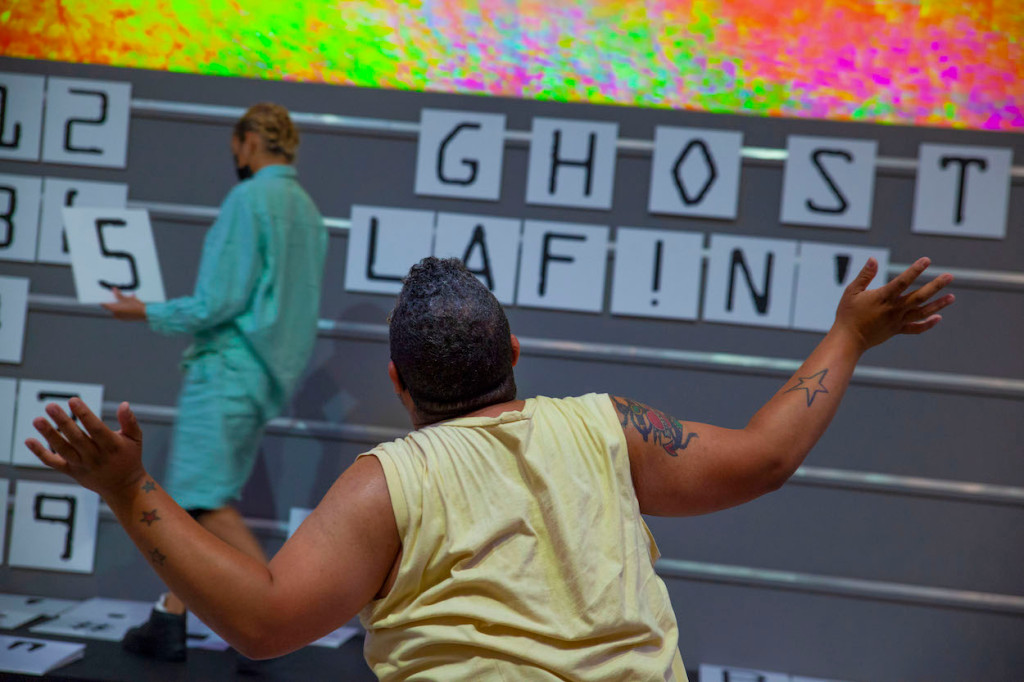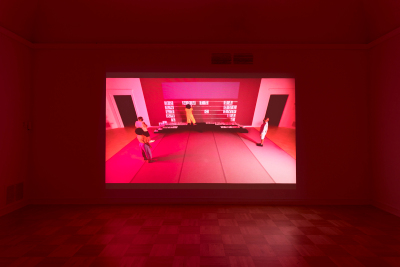 View of “Will Rawls: Everlasting Stranger,” 2021, at Henry Art Gallery, showing dancers Akoiya Harris and Fox Whitney. Photo: Stephen Anunson
View of “Will Rawls: Everlasting Stranger,” 2021, at Henry Art Gallery, showing dancers Akoiya Harris and Fox Whitney. Photo: Stephen Anunson
In his first solo exhibition, “Everlasting Stranger,” at Seattle’s Henry Art Gallery, New York–based choreographer, performer, and writer Will Rawls charts complex relations among gesture, language, and image. In the performances that anchor the exhibition, four dancers methodically move letter tiles hung on a gallery wall to spell out abstract phrases while shifting within the frame of an automated camera that takes a photograph every few seconds. From a stone rotunda at the entrance to the exhibition, an audio track of excerpts recited from Guyanese writer Wilson Harris’s 1987 surrealist novel The Infinite Rehearsal plays and echoes through the halls of the exhibition. Further on, pixelated wall paintings, black geometric sculptural forms, and looped stop-motion animations of the dance flank the performance space. Across six galleries, the installation plays with ruptures and compressions of time. Below, Rawls discusses the role of the glitch in his work, and the seen and unseen labor of dance. “Everlasting Stranger” is on view through August 15.
AURORA SAN MIGUEL Exhibitions make things highly visible to an audience. Throughout the show, however, you also attempt to obscure certain elements: missing frames in the projected stop-motion videos create glitches while the live performers’ movements into and out of view of the camera also point to a type of glitch.
WILL RAWLS The glitch is the moment when you recognize a break in the flow of technology. Humans like to explore technology partly to see it fail to fully mimic or represent human life. Representation is a faulty human invention—this is always the starting point for my work. I insist on this faultiness in “Everlasting Stranger.” I’ve also wondered how to explore dance documentation that acknowledges its failure to capture the live dance, and becomes an artwork itself. Stop-motion animation is a super-durational form of filmmaking that can reflect the time it takes to create a dance. Stop-motion is intensively photographic, requiring eight hundred photos for roughly one-and-a-half minutes of animation. This amplifies the capture of the body and alludes to photography’s legacy of distorting representations of Black and brown people. Dance is a dynamic counterpoint because it eludes language and image. When you watch the stop-motion pieces, you can sense the gestures that are missing between frames, and so the kinetics that you do see on the screen are structured by those missing gestures.
SAN MIGUEL The exhibition makes apparent the intense labor involved in both the performances and their recording. I was particularly struck by the audible clicks of the camera as a type of metronome for the dancers. Between clicks there is a measure of intent in each of their moves.
RAWLS I wanted to foreground dance’s relation to music and to marked time. I also wanted to present the human labor of becoming a moving image, the duress of being captured on camera. The dancers and I discussed the interval, or what transpires between shutter clicks—sensation, thought, and choice—as things that the camera can’t quite capture but that the live audience sees and feels. The interval between photographs is a space of play.
 View of “Will Rawls: Everlasting Stranger,” 2021, at Henry Art Gallery. Dancers: Alyza DelPan-Monley, Akoiya Harris, Fox Whitney, and Nia Amina-Minor. Photo: Jueqian Fang
View of “Will Rawls: Everlasting Stranger,” 2021, at Henry Art Gallery. Dancers: Alyza DelPan-Monley, Akoiya Harris, Fox Whitney, and Nia Amina-Minor. Photo: Jueqian Fang
SAN MIGUEL What happens to the photos and videos after the exhibition, and what is their function as documents of this slowness? Video can easily become another mechanism for speed and reductionism.
RAWLS I’m attached to the films and videos of Kara Walker and William Kentridge, who both, albeit differently, deal with animation’s complex relationships to text, race, gesture, and history. I feel that both artists address history in a glitchy way, using technologies that belie their infidelity to what they’re representing. I’ll take about 20,000 photos of the performance over the course of the exhibition—still deciding where these will go next.
SAN MIGUEL On New York’s High Line in 2018, in your Uncle Rebus performance, you worked with similar techniques—deconstructing and reconstructing movable letter tiles into isolated phrases. I am curious about your choices of language and their source text that comes up in the performance and, in the form of sonic excerpts, before you enter the gallery space.
RAWLS The Infinite Rehearsal is a surrealist novel about a child’s fever dream in which author Wilson Harris examines the genealogy of identity as a problem of quantum physics. I distilled the novel into a set of stanzas that the performers spell, line by line, using oversize letters. The performers don’t have enough letters to fully spell the phrases and are prompted to replace letters with punctuation. One of my favorite lines from the text is “Come and live with me before the world ends.” This appears in the performance as: “BE–4 / THA / WRLD ENDS.” In the process of spelling, the wall becomes a space of emergence for syllables, phonetics, typos, dialects, even stammers between sentences. Deleuze describes stuttering as language growing from the inside out; that disruption of normative language attracts me. I’m drawn to the moment when a dialect emerges from—or, rather, against—a standard English narrative or any kind of master text. As a Caribbean author, Harris writes about consciously crafting language as a political form of self-study, imagination, and expression. I see parallels between his work on creolization and the Black American oral tradition. That was my starting point for deconstructing language and movable type in Uncle Rebus, where I intervened in Brer Rabbit tales to render the narration perhaps more opaque but also more personal and fluid. These projects have been a meaningful way to expose how dancers’ thinking manifests in language, over time.
Source link : https://www.artnews.com/art-in-america/interviews/will-rawls-henry-art-gallery-seattle-1234601546












